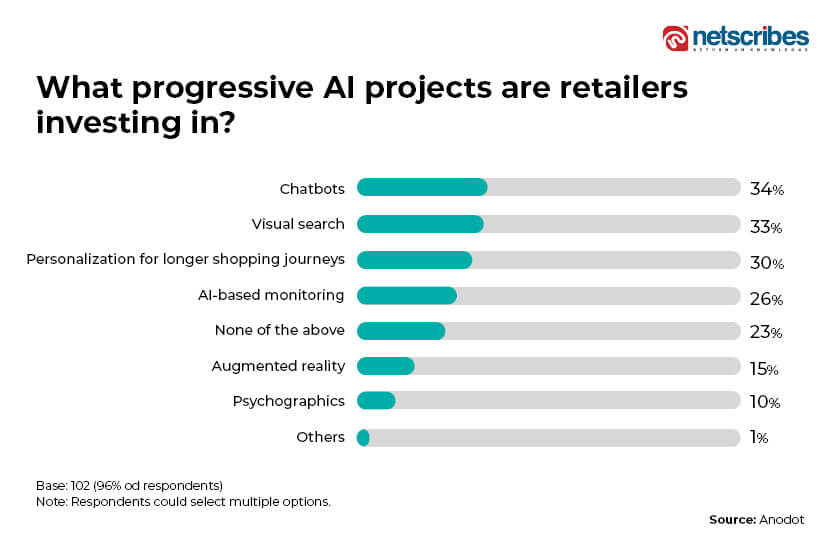Drones that ship lightweight deliveries. Virtual fitting rooms. Shoppable videos. Voice-based shopping. AI in digital commerce has a myriad of avatars.
A third of companies believe AI can help increase e-commerce revenues by 40%. Studies suggest that the expected rise in e-commerce sales will drive the market value of AI in retail to USD 36,462.5 million by 2030 from an estimated USD 1,714.3 million in 2021.
E-commerce as a business generates tons of unstructured data that can be monetized. What separates winners from the rest is the ability of companies to harness the power of AI to transform these data volumes into insights that can be acted upon quickly. Moreover, with customers going digital, AI is helping retailers analyze scores of data – a task that is humanly impossible – whether it’s to drive personalized engagement or predict location-specific sales to make strategic pricing and inventory decisions, and more.
Take a look at how retailers plan to use AI to improve their digital commerce performance.

To know how you can harness the maximum potential AI presents for your e-commerce business these top 10 industry use cases are worth considering:
1. Chatbots and virtual assistants
Customer preferences are constantly evolving, turning new conveniences into table stakes. By 2024, it’s estimated that chatbots will drive USD 142 billion in consumer retail sales worldwide. Online players are therefore competing on providing the most seamless and engaging customer experience that compels visitors to never leave their website without a purchase.
Chatbots are one way to make that happen as they help offer customer support round the clock. Advanced chatbots interact with customers based on their personal preferences equipping businesses to respond in the most appropriate way in real-time. For instance, Sephora’s Kik bot can help find a product used by celebrities, narrow down your options based on a quick quiz, check out product reviews, and more all using pop-up responses.
Source: PinnacleCart
There are also brands developing innovative chatbots for pure engagement. For instance, Casper the mattress company designed its SMS-based Insomnobot 3000 to keep insomnia sufferers between 11 pm to 5 am company, like friends with good humor.
Virtual assistants like Siri, Alexa, and Google are some of the most advanced applications. Besides helping customers discover and buy products purely through voice commands, they capture customer preferences and connect the most promising leads to actual human employees to drive better conversions, retention, and loyalty.
2. Visual search
As shoppers sometimes certain products tend to catch our attention, like a designer dress at a party. Our next impulse is to search for it online, however, with a simple textual description, it could be difficult to find that exact item. Here’s where visual search helps. Shoppers can simply take a picture of the product and upload it on a visual search engine like Google images or Pinterest Lens, to quickly find it online.
Visual search is enabling quicker product discovery to help e-commerce companies accurately categorize products for better offline-online user experiences. It helps drive both new levels of customer satisfaction and operational efficiencies. A few examples of retailers already exploring visual search –
- Argos’ AI-powered visual search allows users to take homeware photos and find similar items across the retailer’s online catalog
- Ikea shoppers can visualize products in the context of their own homes via an app
- Amazon, Pinterest, and many others are enabling users to find what they like from an outfit to a plant without the need to describe it
Brands like Nike are taking it to the next level. Nike shoppers can find their true shoe size using a mix of artificial intelligence and augmented reality by simply scanning their feet digitally.
Source: Nike
3. Personalization
Engaging every customer based on their unique needs and preferences directly impacts conversions. Studies show that 80% of consumers are more likely to make a purchase when brands offer personalized experiences. So whether it’s personalized ‘customers also bought’ product bundling that show up on your product page, or tailored recommendations in an abandoned cart email, AI is helping online retailers scale personalization beyond these mere table stakes.
For instance, Amazon Prime Wardrobe launched a shopping service wherein Prime members had to fill out a simple survey about their styles and fit preferences to get personalized recommendations from a team of stylists across more than half a million products.
Other ways digital commerce players are employing AI-based personalization include:
- Changing the homepage based on a shopper’s browsing behavior is the most popular action for 36% of retail sites.
- 56% of retailers got the best ROI from personalized messaging—such as promotional materials, loyalty programs, and abandoned cart messages.
- Customers receiving ads based on their activity on a site has led to a 38% growth in the product’s revenue.
4. Dynamic pricing
Customer demand and market scenarios are constantly changing. Add to it the latest competitor developments. Dynamic pricing is a technique that enables brands and retailers to factor in such fluctuations and constantly adjust their product prices, often within minutes.
For savvy online players, AI is helping analyze volumes of pricing information and seasonal price changes, inventory conditions, supply and demand relations, weather conditions, base costs, and other market information. These technologies offer real-time pricing recommendations, and the ability to automate price changes in a fraction of time to maximize profitability without hurting brand value.
While this tactic is commonplace in the travel industry, e-commerce stalwarts utilize it most to compete with each other, especially on big sales days. That said, even without these sales days Amazon typically changes its prices every ten minutes on average. Prices can also differ between a shopper adding a product to their cart and paying for it — which has boosted Amazon’s profits by 25%.
5. Inventory management
According to Forrester, omnichannel fulfillment is a high or top priority for 94% of retailers. Many legacy inventory management systems are established on demand forecasting algorithms that lack channel-specificity, making it difficult to analyze online shopper demand trends.
By analyzing long-term patterns in customers’ buying behavior in a specific location predictive analytics algorithms powered by AI can accurately forecast required products and their volumes for warehouses based on their locations. Thus, AI can help anticipate demand, reduce wastage and minimize out-of-stock scenarios.
AI helps scan, locate, and update stock information at scale at affordable costs. These systems can also be deployed to automate packaging and monitor and maintain optimal temperature, humidity, lighting, and other conditions inside warehouses for specific products.
6. Fake review detection
Almost 4% of all online reviews are fake, and they cost e-commerce companies somewhere close to USD 152 billion. Online reviews can make or break your brand reputation. Therefore, every e-commerce platform needs to keep a keen eye out on what is being said about their brand across the internet.
AI can help with this herculean task. By identifying certain peculiar characteristics of a fake review, AI can effectively glean the invalid reviews from the genuine ones made by verified customers, at least on your e-commerce platform. Here are a few examples of the different types of fake reviews and how they are typically identified. By weeding out such reviews, e-tailers can ensure customers get a bankable online experience to base their next purchase decisions.
Source: Frontiers.in
7. Customer segmentation
AI helps continuously collect data on how customers shop, when they buy, and what triggers help them narrow down on a product. Such data points can rarely be captured on store floors easily. Equipped with such precise information, AI is helping marketers connect and optimize their engagement with customers using hyper-targeted ads and marketing communication.
This allows e-tailers to nudge shoppers further into the conversion funnel through timely and relevant product recommendations. AI also helps optimize discounts to maximize margins and profitability by showcasing customer segment-wise discounts based on their average order value.
Related reading: Customer segmentation strategy: 3 ways to drive your brand growth
8. Automated product tagging
From a cataloging perspective, AI in digital commerce is enabling automated tagging of products for better searchability at scale. Given the volume of details and specifications mapped to products It becomes highly crucial to ensure they have been accurately tagged when showcased on the website.
Here’s where a few rounds of manual product tagging for aspects like color, size, material, origin, etc., can help develop effective training data. This data can then be emulated by AI algorithms to automate the tagging process for scores of products. Appropriate tagging is highly critical in making products easily discoverable and keeping your digital catalog well-organized.
9. Headless commerce for continuous innovation
By decoupling an e-commerce platform’s front-end from the back-end headless commerce allows seamless integrations of the latest features built for customer convenience and operational efficiency. According to Forbes, over USD 1.65 billion in funding was raised for headless technologies in 2020-2021 alone.
Powered by AI, this technology provides ample flexibility almost like that of a plug-and-play of various APIs based on your business priorities. It not only facilitates higher control over your content, customer journey, and checkout but also enables you to stay agile enough to keep pace with your competitor and market-driven innovations.
10. Assortment intelligence
Even though digital shelves are limitless it’s not possible to keep a steady stock of all the possible products under a single brand. For e-tailers to be smart about which products to keep, carry or drop based on the dynamics of competition, customer, and market demand, and discounting among other aspects, assortment intelligence helps.
Using certain AI algorithms what this technology essentially does is scans your competitors’ websites to check their stock availability, variations of a particular product, and its positioning on search result pages. It then delivers this information to help your assortment managers make real-time, research-backed navigations into their assortment planning.
All in all, AI has been revolutionary in spurring effective operational and marketing optimizations in digital commerce. However, the success of any AI algorithm powering these use cases depends on the quality, accuracy, and relevance of the training data that builds its foundation.
Leading online retailers and marketplaces have been leveraging Netscribes data labeling and annotation solutions to ensure the output delivered from their ML models is nothing short of the best. To know how you can take advantage of the latest e-commerce technologies to achieve your growth objectives contact us.






